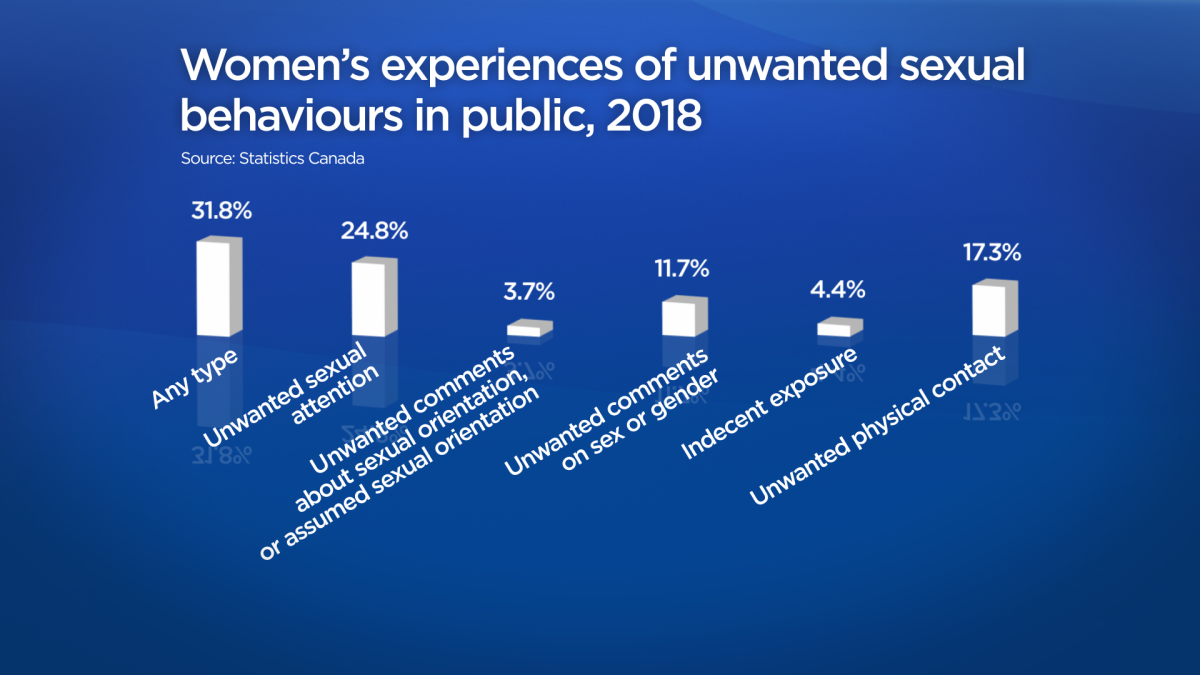One-third of Canadian women have felt unsafe in public due to the behaviour of someone else, according to a survey conducted by Statistics Canada.

Those public places include coffee shops, the street, shopping malls, public transportation, bars and restaurants — anywhere there is little or no restriction of entry.
It found that 32 per cent of women in Canada over 15 years of age — 4.9 million individuals — have experienced some form of unwanted sexual behaviour while they were in public in 2018. That’s more than double the number of men surveyed who said the same, at 13 per cent.
The Survey of Safety in Public and Private Spaces, released Thursday, looked at a range of unwanted behaviours, including touching, getting too close in a sexual manner, unwanted comments on sex, gender or sexual orientation, and acts such as whistling or catcalling.
Adam Cotter, an analyst with StatCan, explained that the new survey fills a gap in data that hasn’t gotten much attention before.
“Since the 1990s, we’ve collected data from Canadians on their experiences with various types of criminal behaviour like physical and sexual assault,” he said. “But we also know that gender-based violence can comprise a wide range of behaviours, and not all of them are necessarily criminal.”
- Life in the forest: How Stanley Park’s longest resident survived a changing landscape
- ‘Love at first sight’: Snow leopard at Toronto Zoo pregnant for 1st time
- Carbon rebate labelling in bank deposits fuelling confusion, minister says
- Buzz kill? Gen Z less interested in coffee than older Canadians, survey shows
Cotter said the survey looks at those instances, which are not criminal but still negatively affect society.
The most common form of unwanted behaviour, which 25 per cent of women experienced, was sexual attention, such as comments, gestures, body language, whistles or calls.

Seventeen per cent of women said they experienced unwanted physical contact, while 12 per cent said they had received comments on sex, gender or their appearance.
Many of those who experienced unwanted behaviours said it often happened more than once. Forty-five per cent of women who experienced unwanted sexual attention said it happened at least three times over the course of one year.
Cotter noted the survey found that the victims of criminal and non-criminal unwanted sexual behaviour are often the same. He added that women, non-heterosexual individuals and younger people are most often victims.
“So you’re at higher risk of experiencing these behaviours regardless of where they fall on the continuum ranging from unwanted comments and jokes to criminal behaviour like physical and sexual assault,” he said.
Where do these incidents happen?
There weren’t many regional disparities, the survey added — women were more likely to face these incidents across Canada. The survey did find that larger cities and urban areas saw more incidents.
One in three women living in a metropolitan area had experienced unwanted sexual behaviour in public, while one in four women living in rural areas or outside cities said the same.
Cotter noted that this may be due to the fact that there are simply more public spaces in large cities.
Cities in which women reported more incidents included Ottawa, Toronto, Regina, Calgary, Vancouver and Victoria.
About 88 per cent of women said a man was responsible for the “most serious instance” they experienced. Women said the man was usually a stranger.
The survey also found that incidents women experienced were most likely to happen at a restaurant or bar, followed by the sidewalk or street. The third most common location was public transit.

Women reported changing own behaviour, emotional impact
More than half of women who experienced unwanted sexual behaviour said it led to them changing their routines or own actions — a finding that Anuradha Dugal of the Canadian Women’s Foundation called “extremely concerning.”
“It goes back to the idea that somehow women are to blame for what they experience,” Dugal said.
“It often ends up being that women can’t be in public spaces at certain times, they can’t go running, they can’t take part in activities that are interesting and exciting for them.”
Women surveyed also said that they experienced a negative emotional impact from the incidents, most commonly feelings of annoyance, cautiousness and awareness, anger, and confusion or frustration.
About 28 per cent of women said they were fearful after the incidents.
Possible solutions
Addressing unwanted sexual behaviours in public spaces is a complex issue because each setting comes with unique challenges, Dugal said.
She noted the example of signs some cities have put up on public transportation that warn passengers of consequences. Some festivals and public events also have trained staff walking around watching for such instances, she added.
At a restaurant or bar, she said someone could speak to a waiter or manager. At a mall, there are security guards.

While bystanders can play important roles, Dugal said that’s not an adequate solution, either — especially in instances where intervening could jeopardize their safety.
“Bystander intervention is a very, very delicate line that we all struggle to properly address,” she said. “It’s a hard thing to do in a public space. Sometimes it works and sometimes it will escalate and turn into something nastier.”
She added that some of the safer ways for bystanders to help are asking the woman if she is OK, helping her move away or starting an unrelated conversation with her.
Dugal said part of the solution is organizations and communities taking action to make spaces safer. She highlighted the example of safety audits, which can be done on public spaces.
“You walk around the town or the area and you describe what goes on and what’s unsafe about these particular areas,” she said.
In some cases, there may be easy fixes, such as adding lighting or a security camera at a bus stop.







Comments